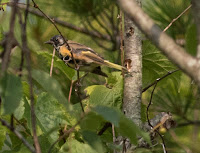Species: Scarlet Tanager
Family: Cardinalidae
Date: 5.20.16
Observation:
We spotted a Scarlet Tanager skipping from treetop to treetop off the east side of the house. He seemed very disinterested in the swarm of newly hatched flies next to him (seen in the photo below).
We spotted a Scarlet Tanager skipping from treetop to treetop off the east side of the house. He seemed very disinterested in the swarm of newly hatched flies next to him (seen in the photo below).
A Fact:
Scarlet Tanagers are long distance migrators. They breed in eastern North America and migrate to northern South America for the winter.
Learn More at All About Birds: Scarlet Tanager





























